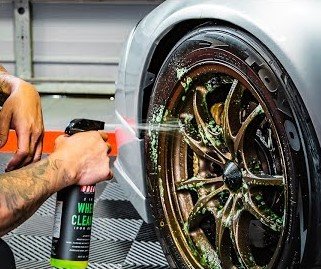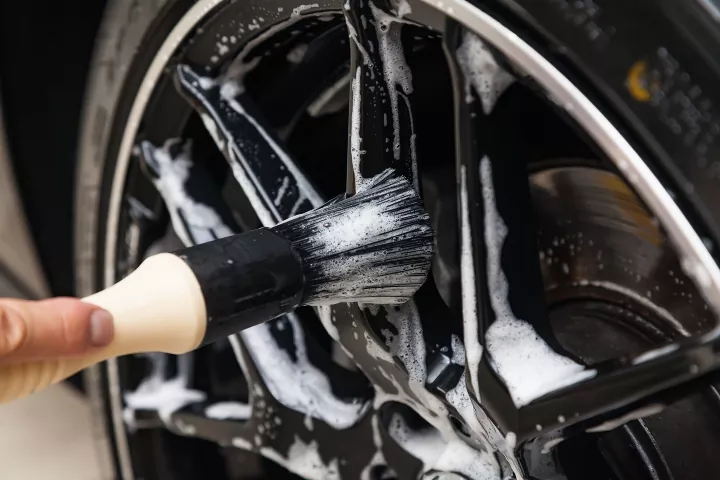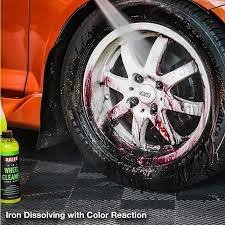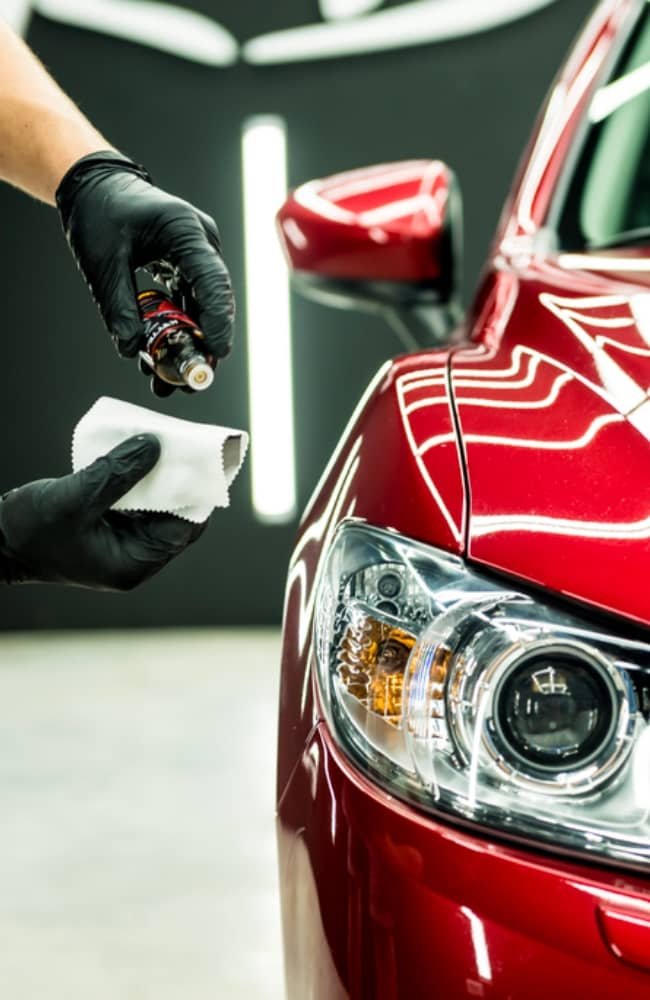How to Remove Brake Dust from Your Wheels Using Chemical Cleaners
By Ammar Hassan Merie | November 03, 2024

Brake dust is a common issue for car owners, often making wheels look dirty and worn. This dust results from brake pad and rotor wear, and when left unaddressed, it can build up and damage the wheel finish. Fortunately, with the right chemical cleaners and techniques, you can restore your wheels to a shiny, like-new appearance. Here’s a comprehensive guide to removing baked on brake dust from your wheels effectively and safely.
Why Baked on Brake Dust Removal is Important

Brake dust is more than an aesthetic problem—it’s also slightly corrosive. When left on your wheels, it can bond to the surface, causing staining, pitting, and even corrosion. Regular cleaning protects your wheels from permanent damage and keeps your vehicle looking its best.
Choosing the Right Wheel Cleaner: Safety and Effectiveness
When removing brake dust, detailers typically choose between household and commercial products, each with pros and cons. We recommend using commercial products specifically designed for car detailing. These cleaners are engineered to be more effective than homemade solutions.
When it comes to commercial wheel cleaners, opinions on their safety can vary. The key is choosing the right type for your wheels.
Acidic Wheel Cleaners
These dissolve ferrous metals like brake dust but generally don’t affect most plastics, which is why they’re often sold in plastic containers. Acidic cleaners work well on modern coated aluminum wheels but should be used cautiously to avoid damage. Follow the manufacturer’s instructions carefully, wear nitrile gloves and safety goggles, and dilute concentrates as directed to prevent chemical burns or wheel damage.
Non-Acidic Wheel Cleaners
Although non-acidic cleaners are often chosen for their perceived gentleness, many are highly alkaline and can still be corrosive. Look for pH-balanced formulas if you want a milder option, though effectiveness may vary. For stubborn brake dust, choose a cleaner with catalysts specifically for dissolving ferrous particles.
Tools and Products You’ll Need

Before you get started, gather these tools and products:
- Wheel Cleaner: Choose a cleaner specifically designed for removing brake dust. Look for formulas that are safe for the type of wheels you have (alloy, chrome, painted, etc.).
- Soft-Bristle Wheel Brush: A soft-bristle brush will help lift the brake dust without scratching the wheel’s finish.
- Microfiber Towels: These are essential for wiping down the wheels and preventing streaks.
- Water Source: You’ll need a hose or a spray bottle with clean water.
- Wheel Sealant (Optional): Applying a sealant afterward can help repel brake dust and keep your wheels cleaner for longer.
Step-by-Step Guide to Cleaning Baked on Brake Dust from Wheels
Step 1: Rinse Your Wheels Thoroughly

Start by rinsing each wheel with water to remove loose dirt and grime. This step is crucial, as it prevents any large particles from scratching the wheel surface during cleaning.
Step 2: Apply the Chemical Cleaner

Spray your chosen wheel cleaner generously over the entire surface of the wheel, paying extra attention to areas with a lot of brake dust buildup, such as around the lug nuts and inner barrel. Most chemical wheel cleaners are designed to work on contact, but check the manufacturer’s instructions for any wait time recommendations.
Step 3: Allow the Cleaner to Sit

After applying the cleaner, let it sit for the recommended time, usually between 1 to 3 minutes. During this period, the cleaner will break down the brake dust and loosen stubborn grime. Avoid letting the cleaner dry completely, as this could make removal more challenging.
Step 4: Use a Soft-Bristle Brush to Scrub

Using your soft-bristle wheel brush, gently scrub the surface of the wheel. Focus on heavily soiled areas and crevices where brake dust tends to accumulate. For hard-to-reach spots, consider using a smaller detailing brush to ensure every area is covered.
Step 5: Rinse the Wheel Again

Once you’ve scrubbed the wheel thoroughly, rinse it with clean water to remove the cleaner and loosened brake dust. Ensure there are no traces of the cleaner left, as residue can attract more dirt over time.
Step 6: Dry and Inspect

Use a microfiber towel to dry the wheel completely. Drying not only prevents water spots but also allows you to inspect your work. If any brake dust remains, you can repeat the process on those areas for a spotless finish.
Step 7: Apply Wheel Sealant (Optional)

Applying a wheel sealant can provide a protective barrier, making it harder for brake dust to bond to the wheel’s surface in the future. This step is optional but highly recommended if you want your wheels to stay cleaner for longer.
Using Brake Dust Erasers

Brake dust erasers are helpful for tackling baked-on brake dust. These non-abrasive pads are designed to attract brake dust without scratching your wheels. They’re especially effective for reaching hard-to-clean areas like curves, corners, or lug nut cavities. We highly recommend having a brake dust eraser on hand for stubborn spots.
Tips for Preventing Baked on Brake Dust Buildup
- Clean Wheels Regularly: Regular cleaning helps prevent heavy buildup and makes future cleanings easier.
- Use a Wheel Sealant: As mentioned, sealants create a slick surface that repels brake dust and keeps wheels looking cleaner.
- Switch to Low-Dust Brake Pads: If brake dust is a persistent problem, consider using ceramic or low-dust brake pads, which produce significantly less dust than traditional ones.
Monitoring Tire Health and Periodic Inspections
Monitoring your tires’ health and scheduling periodic inspections can go a long way in ensuring your vehicle’s safety and optimizing performance on the road. Tires are your vehicle’s only contact with the pavement, and their condition directly impacts how your vehicle handles, brakes, and accelerates.
To maintain tire health and safety, consider the following:
- Tread Depth Check: Ensure your tire tread is above the minimum legal limit, as recommended by the manufacturer, to maintain grip and prevent hydroplaning.
- Pressure Adjustments: Regularly check and adjust tire pressure to the manufacturer’s specifications to ensure optimal contact with the road and prevent uneven wear.
- Visual Inspections: Look for signs of damage, such as cuts, bulges, or foreign objects that could lead to tire failure.
- Rotation Schedule: Follow the manufacturer’s suggested tire rotation pattern to promote even tire wear and extend the life of your tires.
Safety Tips
- Use Gloves and Eye Protection: Chemical cleaners can be harsh, so protect your skin and eyes while using them.
- Test in a Small Area First: Always test the cleaner on a small, inconspicuous area to ensure compatibility with your wheel’s finish.
- Avoid Using Acidic Cleaners on Uncoated Wheels: Some cleaners contain acids that can damage certain wheel finishes, so check your cleaner’s ingredients if you’re unsure.
Summary
Maintaining clean wheels not only boosts your car’s appearance but also prolongs their lifespan. With the right products and techniques, you can tackle stubborn brake dust and keep your wheels looking new. Regular cleaning and inspections go a long way in keeping brake dust at bay and ensuring your wheels shine. Drive confidently, knowing your wheels are at their best!



